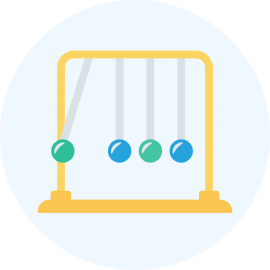Political Parties Chapter Notes | AP U.S Government and Politics - Grade 12 PDF Download
Introduction
Linkage institutions are vital connections between citizens and their government, helping people participate in the political process and influence policy decisions. These institutions—political parties, interest groups, elections, and the media—act as communication channels, allowing individuals to express opinions, support candidates, and stay informed. Each plays a unique role in promoting civic engagement, shaping public discourse, and ensuring government accountability. In a democracy, linkage institutions are essential for translating public needs into government action.
Linkage Institutions: Connecting People to Power
Linkage institutions are societal frameworks that link citizens to their government. They serve as conduits for communication, enabling individuals to articulate their preferences, raise issues, and impact policy decisions. The four main linkage institutions highlighted in AP US Government are political parties, interest groups, elections, and the media. Each plays a unique role in influencing public dialogue, ensuring accountability of officials, and fostering civic engagement.
Political Parties
Political parties unite individuals with common values and political objectives. They provide voters with a platform detailing their stances on critical issues and strive to elect candidates who align with those views. Beyond campaigning, parties facilitate policy coordination, organize legislative leadership, and form coalitions.
- Offer a clear label for voters to identify with
- Coordinate campaigns and raise funds
- Create and advocate for party platforms
- Engage voters through outreach efforts
Political parties are essential to representative democracy. Without them, voter participation would likely decrease, and political coordination within government would become more disjointed.
Interest Groups
Interest groups concentrate on specific policy areas rather than broad agendas. Their main aim is to shape legislation, not to secure electoral victories. They employ strategies like lobbying, legal action, and public campaigns to advocate for favorable policies or regulations.
Examples include:
- National Rifle Association (NRA) – advocates for gun rights
- Sierra Club – promotes environmental protection
- AFL-CIO – champions labor rights
- American Medical Association (AMA) – focuses on health policy
Interest groups strengthen democratic participation by amplifying specialized concerns, though some critics contend they can disproportionately represent elite or corporate interests.
Elections
Elections provide a direct mechanism for citizens to influence government composition. They decide who holds public office and are a prominent tool for democratic accountability.
- Allow voters to oust officials who no longer align with their values
- Require candidates to gain support through debates and campaigns
- Facilitate policy discussions during campaigns, informing the electorate
Through elections, political legitimacy is reaffirmed, ensuring elected leaders remain responsive to public needs.
Media
The media serves as a bridge between the public and political information. It shapes policy narratives, exposes government wrongdoing, and provides a platform for discussion. In a democracy, the media acts as a watchdog, promoting transparency.
- News coverage determines which issues gain prominence
- Political commentary influences voter perspectives
- Social media has transformed the speed and reach of political communication
However, challenges like media bias and misinformation can hinder informed civic participation.
The Function and Impact of Political Parties
Political parties extend beyond running candidates; they significantly shape the electoral and legislative landscape. Their influence is evident in campaign operations, legislative drafting, and efforts to educate and mobilize citizens.

Mobilization and Education of Voters
One of the critical functions of political parties is to encourage electoral participation. This involves voter outreach, education initiatives, and registration campaigns.
- Parties deploy volunteers for door-to-door canvassing, phone calls, and text messaging
- Social media is a key tool for engaging younger voters
- Party-affiliated groups distribute brochures, hold rallies, and provide sample ballots
Real-World Application: Before national elections, major parties intensify canvassing in battleground states. In 2020, the Biden campaign prioritized digital outreach, while Trump’s team focused on large in-person events.
Voter mobilization is not only about securing electoral wins but also about fostering sustained civic and community engagement.
Party Platforms
A party platform is a formal declaration of a party’s objectives and policy priorities, revised every four years at national conventions.
These platforms function as campaign pledges and reference points. Once in office, party leaders use them to steer legislative priorities.
Note: Platforms are not legally enforceable but represent political commitments that voters can use to hold officials accountable.
Candidate Recruitment and Campaign Management
Political parties actively seek candidates who are compelling, experienced, and aligned with party principles. Recruitment spans all levels, from local school boards to presidential contests.
Once candidates are selected, parties support them with:
- Fundraising efforts
- Hiring campaign staff and consultants
- Crafting media and messaging strategies
- Organizing public events and advertisements
 Effective campaign management reflects a party’s organizational strength, infrastructure, and voter connection. It also reinforces party identity and cultivates loyalty.
Effective campaign management reflects a party’s organizational strength, infrastructure, and voter connection. It also reinforces party identity and cultivates loyalty.
Committee and Party Leadership Systems in Legislatures
Once elected, officials rely on their party for legislative coordination. Leadership positions in Congress, such as Speaker of the House or Senate Majority Leader, are determined by party majorities.
- Parties assign committee memberships and chair roles
- Leadership sets the legislative schedule and oversees floor debates
- Party discipline ensures cohesive voting on critical legislation

These systems promote party unity, facilitating the passage or obstruction of laws based on a cohesive strategy. The larger the majority, the greater a party’s control over the legislative process.
Key Terms
- American Federation of Teachers (AFT): The American Federation of Teachers (AFT) is a national labor union representing educators, school staff, and higher education faculty across the U.S. Founded in 1916, it advocates for educational improvements, better workplace conditions, and the professional interests of its members while engaging in political efforts to influence education-related policies.
- American Veterinary Medical Association (AVMA): The American Veterinary Medical Association (AVMA) is a professional organization representing U.S. veterinarians. It works to advance veterinary medicine, promote animal health and welfare, and uphold high standards in the profession through education and advocacy.
- Committee and Party Leadership Systems in Legislatures: These systems refer to the organizational frameworks within legislative bodies that support party operations and the legislative process. Committees specialize in policy areas for detailed legislative review, while party leadership roles manage strategy and coordination, significantly influencing policy outcomes through collaboration.
- Elections: Elections are structured processes where voters select public officials, enabling citizen participation in democratic governance. They ensure political accountability, allowing voters to shape government direction, influenced by political parties, constitutional amendments, public opinion, and party ideologies.
- Functions and Impact of Political Parties: This term encompasses the roles political parties play in democracy, such as organizing elections, shaping policy, and representing diverse interests. Parties connect citizens to government, fostering participation and influencing public opinion through political discourse.
- Interest Groups: Interest groups are organized entities that aim to influence public policy to achieve specific objectives. They shape legislation, mobilize citizens, and provide policymakers with information, closely tied to political processes and institutions.
- Linkage Institutions: Linkage institutions are structures that connect citizens to government, facilitating communication and political participation. They shape public opinion, mobilize voters, and provide avenues for expressing concerns, influencing policy and political outcomes.
- Media: Media encompasses communication channels like television, radio, newspapers, and digital platforms that inform the public. It shapes public opinion, facilitates political discourse, and influences political socialization, serving as a vital link between government and citizens.
- National Organization for Women (NOW): Founded in 1966, the National Organization for Women (NOW) is a feminist advocacy group focused on promoting women’s rights and equality. It addresses issues like reproductive rights, gender discrimination, and workplace equity through grassroots activism and legislative lobbying.
- Political Parties: Political parties are groups of individuals with shared political beliefs aiming to influence government policy by electing candidates. They shape the political landscape, enhance voter engagement, and serve as a link between the public and government.
Linkage Institutions and Political Parties<span class="fr-marker" data-id="0" data-type="true" style="display: none; line-height: 0;"></span><span class="fr-marker" data-id="0" data-type="false" style="display: none; line-height: 0;"></span<span class="fr-marker" data-id="0" data-type="true" style="display: none; line-height: 0;"></span><span class="fr-marker" data-id="0" data-type="false" style="display: none; line-height: 0;"></span<span class="fr-marker" data-id="0" data-type="true" style="display: none; line-height: 0;"></span><span class="fr-marker" data-id="0" data-type="false" style="display: none; line-height: 0;"></span<span class="fr-marker" data-id="0" data-type="true" style="display: none; line-height: 0;"></span><span class="fr-marker" data-id="0" data-type="false" style="display: none; line-height: 0;"></span><span class="fr-marker" data-id="0" data-type="true" style="display: none; line-height: 0;"></span><span class="fr-marker" data-id="0" data-type="false" style="display: none; line-height: 0;"></span<span class="fr-marker" data-id="0" data-type="true" style="display: none; line-height: 0;"></span><span class="fr-marker" data-id="0" data-type="false" style="display: none; line-height: 0;"></span<span class="fr-marker" data-id="0" data-type="true" style="display: none; line-height: 0;"></span><span class="fr-marker" data-id="0" data-type="false" style="display: none; line-height: 0;"></span<span class="fr-marker" data-id="0" data-type="true" style="display: none; line-height: 0;"></span><span class="fr-marker" data-id="0" data-type="false" style="display: none; line-height: 0;"></span>
FAQs on Political Parties Chapter Notes - AP U.S Government and Politics - Grade 12
| 1. What are linkage institutions in the context of political parties? |  |
| 2. How do political parties influence voter behavior? |  |
| 3. What roles do political parties play in a democracy? |  |
| 4. What are the major challenges facing political parties today? |  |
| 5. How do political parties contribute to the policy-making process? |  |















